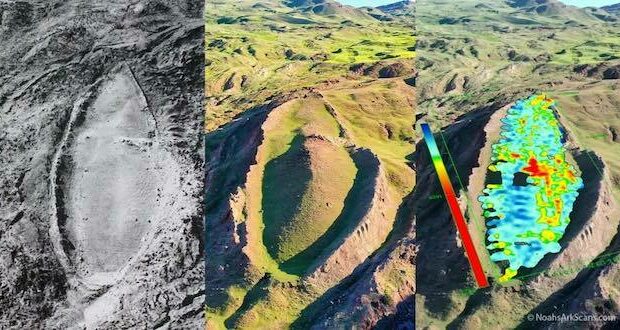Researchers have found ancient human activity and peculiar pottery at a remote eastern Turkish site that some believe is the resting place of Noah’s Ark.
The Durupinar formation, a unique “boat-shaped” geological formation that has drawn interest since its discovery on Sept. 11, 1959, has yielded new findings that, while still being analyzed, may indicate the beginning of humans using a particular firing process in the production of pottery.
Researchers from Istanbul Technical University, Agri Ibrahim Cecen University (AICU), and Andrew University, a private Seventh-day Adventist university in Michigan, presented Durupinar formation study results during a symposium in October at Istanbul Technical University.
The team used ground-penetrating radar to find subterranean layers and “intriguing angular structures,” which Noah’s Ark Discovered Project experts said are “characteristics not typically associated with natural geological formations.”
According to AICU Vice Rector professor Faruk Kaky, initial assessment of more than two dozen rock and soil samples may indicate human activity at the site 5,000 years ago.
Kaky said the archeological items demonstrate significant clay-making skills.
“We saw that these pottery pieces weren’t made entirely of clay,” he added in his presentation. “They were polygenic, consisting of fine clay grains, sand, silt, gravel-sized grains, and rocks of various origins.
“This shows that the artifacts date back 5,000 years. This means that the works at this site go way back. People made them by firing clay right here.”
After an initial archaeological surface survey, which involves walking around the area looking for pottery and taking soil and rock samples, geophysical surveys, core drilling, and possibly a “limited form of excavations” are expected.
Besides the formation’s “boat shape,” ark supporters point to the ark’s dimensions in Genesis: 300 cubits by 50 cubits by 30 cubits, or 164 yards by 27 yards by 16 yards (150 meters by 25 meters by 15 meters), which match the Durupinar formation’s size.
Kaky stated on Oct. 26, “With the dating, it is not possible to say that the ship is here. We need to work for a long time to reveal this.”
Genesis 8:4 says the ark “came to rest on the mountains of Ararat,” but its location and contents are unknown.
Andrew Snelling, Answers in Genesis’ research director says remains of the ark is unlikely to have survived.
“With no mature trees available for Noah and his family to build shelters after they got off the Ark, there is every reason to expect they dismantled the Ark (which they didn’t need anymore) to salvage timber from it,” said Snelling.
Meanwhile, a California State University geologist called the biblical link “bogus,” claiming the feature was a rock formation, not an ancient boat.
A Turkish army captain discovered Durupinar in 1959, but researchers became interested in it in 2021. The site was studied from the 1970s to the mid-1990s by American explorer Ron Wyatt and others.
–Metro Voice
 Metro Voice News Celebrating Faith, Family & Community
Metro Voice News Celebrating Faith, Family & Community









